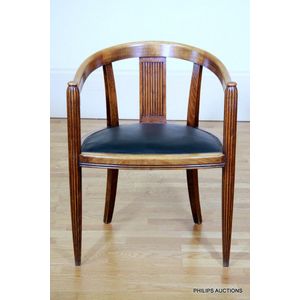Edwardian Shell Inlaid Side Chair
You must be a subscriber, and be logged in to view price and dealer details.
Subscribe Now to view actual auction price for this item
When you subscribe, you have the option of setting the currency in which to display prices to $Au, $US, $NZ or Stg.
- Inlay - Decorative patterns inserted into the main body of a piece of furniture, generally in wood of contrasting colour and grain, though brass, ivory, ebony, shell and sometimes horn have been used. Inlay may consist of a panel of well figured timber inset into a cabinet door front, geometric patterns, or complex and stylized designs of flowers, swags of foliage, fruits and other motifs. As a general rule, in pieces where the carcase is constructed in the solid, the inlay is relatively simple such as stringing, cross banding and herringbone banding. Where more elaborate and decorative work was required veneer was used. Inlay has been fashionable from at least the latter half of the 17th century, when a variety of elaborate forms were developed
- Edwardian - The Edwardian period of English furniture and decorative arts design is named for Edward VII (1841 ? 1910) who was King of the United Kingdom and the British Dominions and Emperor of India for the brief period from 1901 until his death in 1910. It follows the Victorian period, in turn was followed by the Art Nouveau and Art Deco styles. In Australia, designs of this period are also known as being in the Federation style.
- Scallop / Shell Motif - The shell motif has been used in furniture and decorative arts for centuries. In ancient Greece and Rome, shells were often used as decorative elements on furniture and in mosaics. The scallop or cockleshell are the most commonly used. During the Renaissance, the shell motif became popular in furniture and architecture, as the ornate decoration was seen as a symbol of wealth and luxury. In the 18th century, the Rococo style of furniture and decorative arts featured an abundance of shell motifs, and it was used by Thomas Chippendale and as a feature on Queen Anne style cabriole legs. In the 19th century, the shell motif was incorporated into Victorian furniture and decorative items, and often a representation of the the conch shell was inlaid into furniture.
- Marquetry - In marquetry inlay, contrasting woods, and other materials such as ivory, shell and metal are inlaid either as panels or in a single continuous sheet over the surface of the piece. The design may be straightforward, such as a shell pattern or a basket of flowers, or it may be infinitely complex, with swirling tendrils of leaves, flowers and foliage, such as one finds, for example, in the "seaweed" patterns on longcase clocks of the William and Mary and Queen Anne periods.
This item has been included into following indexes:
Visually similar items

An Art Deco oak desk chair, circa 1930s-40s, in the manner of Paul Follot, the honey toned oak chair with a black leather seat and nail trim, having a ribbed rectangular splat flanked by side supports, with slender ribbed supports with squashed knop finial

Assembled set of eight dining chairs, each with reticulated shield back, four Georgian chairs, together with four 20th century chairs (8). Height 92 cm. Width 48 cm. Depth 46 cm

Frank Lloyd Wright (American, 1867-1959), Barrel Chair, Model No. HC109, designed in 1904 for the Darwin D. Martin House, selected by Thomas A. Heinz, manufactured by Bexley Heath Ltd., USA, in 1995, quarter-sawn, solid oak, rounded back, with continuous a

Frank Lloyd Wright (American, 1867-1959), Barrel Chair, Model No. HC109, designed in 1904 for the Darwin D. Martin House, selected by Thomas A. Heinz, manufactured by Bexley Heath Ltd., USA, in 1995, quarter-sawn, solid oak, rounded back, with continuous a
